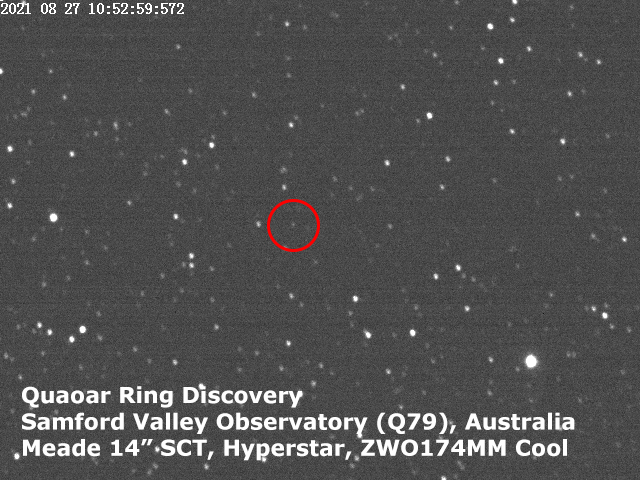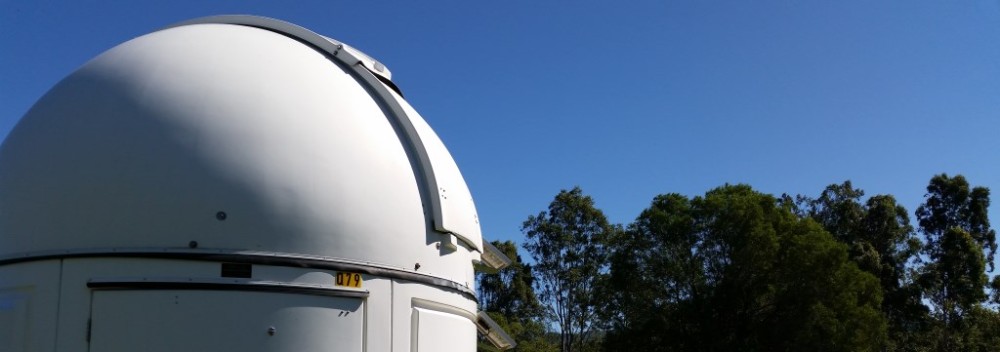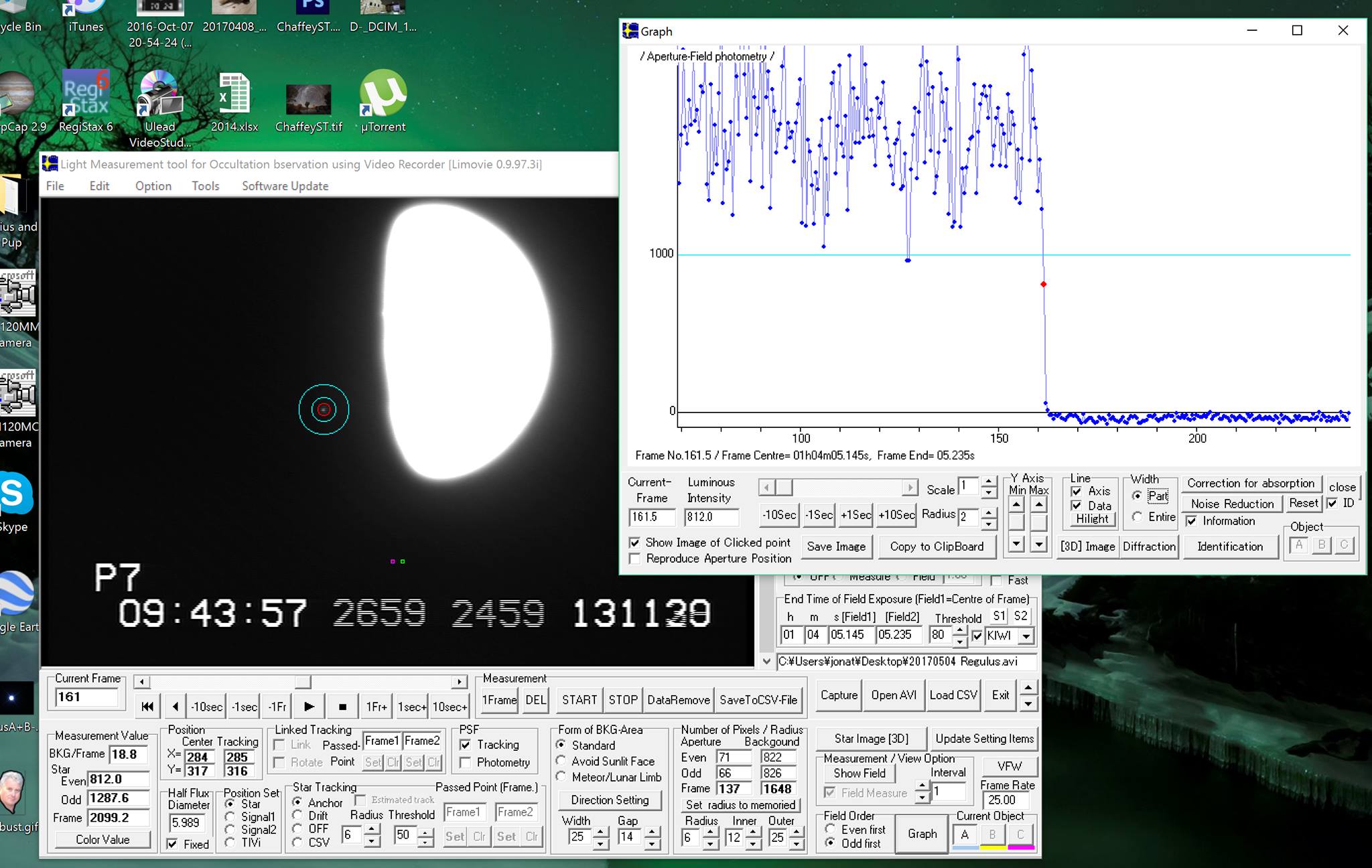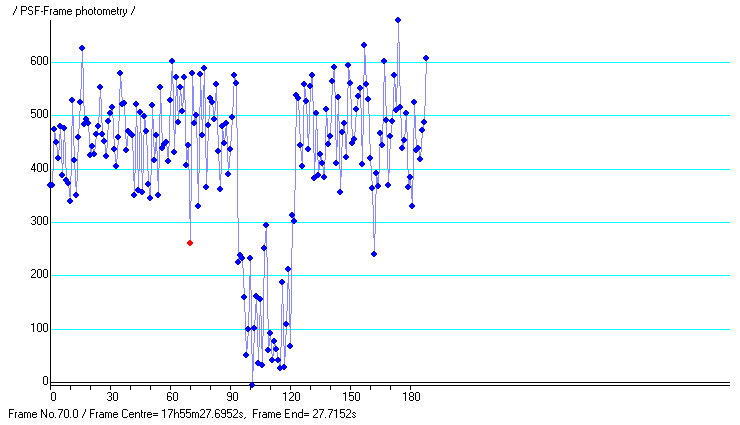Generating path predictions for asteroid occultations:
We essentially need only three inputs to compute a path prediction: the position of the star at the time of the event, the position of the asteroid at the time of the event, and the size/shape of the asteroid. At this point in time, Occult has a database of the maximum diameter for asteroids. Dave Herald compiles this list of diameters from a variety of sources. And, at this point in time, Occult only uses a maximum diameter and does not attempt handle non-circular shapes or orientations for non-circular asteroid profiles. Therefore the primary inputs are really the asteroid position and star position.
For the asteroid position I compute an orbit fit using the latest astrometry of the asteroid. I use the asteroid astrometry from the MPC, the latest astrometry from FASTT (USNO), and the latest astrometry from Bill Owen (also available from the MPC). I generally post updates right after I receive the latest distribution of asteroid astrometry from FASTT. When computing the orbit I use a protocol established many years ago – I increase the weighting for the data from FASTT and Bill Owen. Analysis of past asteroid occultation observations supports the idea that this approach works well.
Although there is some reason to believe that the uncertainty calculated by the orbit fit program is too optimistic – maybe we should increase this formal uncertainty by a factor of 1.3 or so. Hugh Harris (FASTT) and Bill Owen both have a list of the asteroid occultations for each year and both do
a great job of scheduling astrometry for asteroids involved in asteroid occultations.
For the star position I almost always use the position from one of the major catalogs: FK6, Hipparcos (2nd reduction), UCAC4, and PPMXL. Choosing a catalog is simple in theory (pick the most accurate catalog position) but often challenging in practice. Each catalog has strengths and weaknesses.
As David has noted in the past, some of these catalogs are “aging” – particular Hipparcos. The Hipparcos positions are based on observations in 1991. Any errors in the proper motions from Hipparcos increase as we move forward in time. Some of these errors are covered by the formal catalog uncertainties given in the Hipparcos catalog. But all catalogs have systemic, un-modeled, errors and these errors will become more of an issue over time. In addition to concerns about the aging of catalog, sometimes two relatively “similar” catalogs can have roughly equal accuracies but
noticeably different positions. We do not have access to the source data for these catalogs. And we do not have access to state of the art software for fitting proper motion solutions. So we do not have the option to truly build up our own proper motion solution or review the automated proper motion solutions from these catalogs. We have to just choose between two catalogs with no other guidance. In some instances the catalog positions vary by a large amount – perhaps as much as 50 mas. In these situations we have occasionally asked Bill Owen or Hugh Harris (USNO) if they can measure
a current position for the star (astrometry of the star).
However, I am somewhat skeptical of the benefits of stellar astrometry for our events. In my opinion, even 50mas is a big challenge in stellar astrometry. Considering all the potential systemic issues (e.g. zonal catalog errors) I, personally, would not hope for an accuracy of more than 20mas for these measurements. If we are trying to decide between two catalog positions which are 50mas apart then I would trust a good round of stellar astrometry from Bill Owen or Hugh Harris (the best in the world).
But if we are trying to separate two positions at 20mas, I’m skeptical of the value of astrometry of the star alone. In addition, I believe that dim companion stars cause many issues with these positions. A dim companion can easily cause significant disparities between the photocenter measurements
and the actual center of a primary star – at least significant for our purposes. I can easily believe that a dim companion could yield a 50mas offset between the center of a primary and the photocenter – and we would not detect this offset with ground based stellar astrometry. Therefore, stellar astrometry cannot solve all of our problems with star positions. Between today and release of Gaia data, stellar astrometry may be useful in spotting gross positional errors on the order of 30mas or so. For major
events where we plan to commit significant resources, it makes sense to ask for stellar astrometry as a check against catalog positions. But we should not expect that stellar astrometry will yield a noticeable improvement in the overall path statistics on a broad scale.
Asteroid/Star relative astrometry:
I will briefly mention one other option for fine tuning path predictions. In some situations it is possible to image both the asteroid and star on the same frame. We can then directly measure the relative offset between the star and the asteroid with much higher accuracy than possible in other
approaches. In theory, with this approach we might be able to bring the path accuracy down below 10mas. However, there are some challenges. First, most asteroids are moving too fast. Even with unusually large imaging setups the asteroid and star are only in the same frame less than 24 hours
before the event – we don’t have enough time to process the data and get the information to observers in time for deployment. Second, this level of accuracy is extremely challenging for equipment and for the image processing. Hugh Harris has attempted this approach for two asteroid occultation events where the asteroid was moving slowly enough and he had access to a special 60″ astrometric setup. We hoped to use these events as test cases to determine if practice matched theory. Unfortunately, both events were clouded out. And we don’t often have events where the asteroid is moving slowly enough and Hugh has access to the necessary scope. But we are still keeping an eye out for future opportunities to test this approach.
Steve Preston





